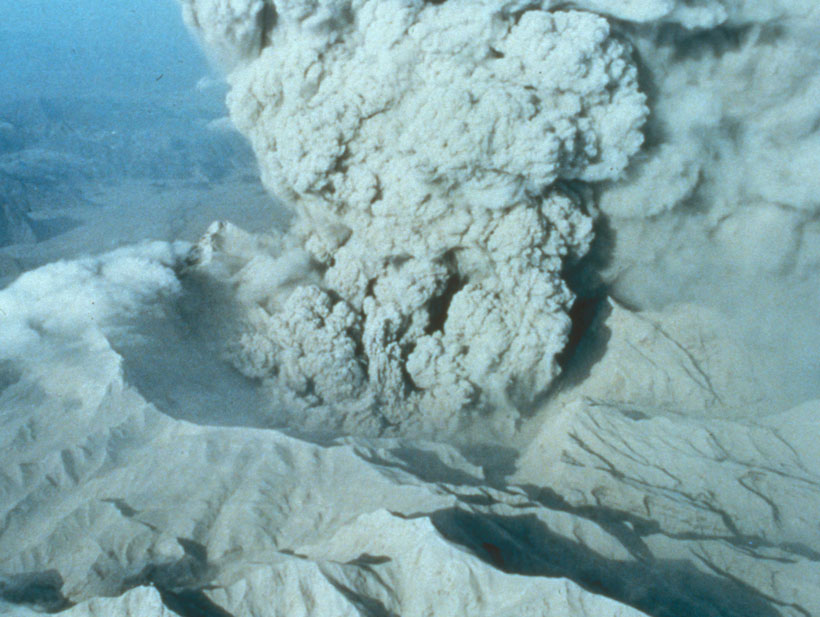From detonating nuclear weapons in the atmosphere to trying to move hurricanes, history is filled with scientists proposing eccentric strategies to control the climate. The latest idea to gain traction involves tweaking Earth’s albedo by injecting the stratosphere with sulfur aerosols in an effort to reflect more sunlight back into space.
When airborne sulfur dioxide dissolves in water vapor, sulfuric acid forms. This acid then dissociates into aerosolized sulfate particles, which scatter sunlight away from Earth. Sulfur aerosols also can affect cloud formation by increasing cloud height, reflectivity, and longevity. Scientists and engineers find these properties attractive—the more sunlight Earth reflects, the less heat it absorbs, leading to a cooler planet.
Injecting the stratosphere with sulfur aerosols using balloons, planes, drones, or a combination of the three wouldn’t be too expensive, explained Alan Robock, a geophysicist at Rutgers University. Robock spoke at a panel discussion at the 2015 meeting of the American Association for the Advancement of Science last week in San Jose, Calif.
However, he and other scientists worry about the global consequences of such a feat. To gain more insight into the way sulfur aerosols affect the globe, scientists turn to nature—specifically, volcanoes.
Volcanic Domino Effect
With every large eruption, volcanoes spew thousands of tons of sulfuric aerosols into the stratosphere and cause brief periods of global cooling. By modeling the effects of large volcanic eruptions, Robock and other scientists found that although injecting the atmosphere with sulfur aerosols could put a dent in global warming by increasing the amount of light reflected away from Earth, the risk of global consequences, such as resulting drought or degradation of the ozone layer, may outweigh any temporary benefits.
In 1783, months after the eruption of Iceland’s Laki volcano, a famine in Egypt killed or drove out one sixth of its population.
The diary of a French nobleman, the count of Volney, supports the model’s findings. According to Robock, the count was living in Cairo in 1783, the same year that the Laki volcano erupted in Iceland. That year, the count reported in his diary that the annual flooding of the Nile, which provides water and nutrients to Egypt, had not been sufficient. Even the next year, flooding was not nearly as widespread, the count wrote.
Months after the eruption, “there was a famine in Egypt, and by the next year, one sixth of the population had either died or left,” Robock said. Famine in India and Japan also struck soon after.
More recently, modern technology has recorded the global effects of large volcanic eruptions. In 1912, for instance, an eruption of Katmai volcano in Alaska preceded record low river flow in both the Niger and the Nile. In 1991, Mount Pinatubo in the Philippines erupted, resulting in record low precipitation in many regions of Earth.
Because stratospheric sulfur aerosols absorb as well as reflect sunlight, the warmer particles, when present in high concentrations, seem to decrease precipitation around the globe by inhibiting the formation of storm clouds. In addition, sulfur aerosols provide a surface for hydrochloric acid (emitted industrially and by volcanoes) to break down into ozone-destroying chlorine and chlorine monoxide, which degrade the atmospheric shield protecting Earth from the Sun’s ultraviolet rays.
Untestable Consequences
In addition to changing precipitation rates and triggering destruction of ozone, climate engineering via stratospheric injection of sulfur aerosols could have unknown consequences for other natural processes, such as plant or wildlife ecologies, Robock said.
Implementing any plan to deliberately change the climate also poses practical challenges. For example, who would control the technology? What steps would be taken to prevent accidental releases of too much aerosol? As Robock asked, how would nations decide “whose hand is on the thermostat?”
Geoengineering—Not a Silver Bullet
Because of the unknown consequences of climate intervention with aerosols, a new report by the National Research Council, discussed by the panel, concluded that geoengineering, or “climate intervention,” is not the best way to combat climate change.
Efforts to address climate change should continue to focus most heavily on mitigating greenhouse gas emissions.
“There is no silver bullet,” said panel speaker Marcia McNutt, editor in chief of Science magazine and former director of the U.S. Geological Survey. “After looking very seriously at methods of climate intervention, we still came to the conclusion that efforts to address climate change should continue to focus most heavily on mitigating greenhouse gas emissions.”
The report also noted that continuing research into sulfur aerosol injection and other human-driven avenues of climate intervention, such as carbon sequestration or alternative ways to modify Earth’s reflectivity, will be important additions to climate mitigation.
—JoAnna Wendel, Staff Writer
Citation: Wendel, J. (2015), Volcanic eruptions steer conversations on climate intervention, Eos, 96, doi:10.1029/2015EO024529. Published on 18 February 2015.
Text © 2015. The authors. CC BY-NC 3.0
Except where otherwise noted, images are subject to copyright. Any reuse without express permission from the copyright owner is prohibited.

